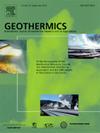Detecting thermal water layer with algorithm model utilizing well-logging reconstruction data: A case study of the Qingshankou formation, Songliao Basin
IF 3.5
2区 工程技术
Q3 ENERGY & FUELS
引用次数: 0
Abstract
The conversion of “oil-geothermal” has become a hot topic in regions where petroleum reserves have been depleted but possess moderate to high ground heat flow values. This shift necessitates a rapid and objective redefinition of thermal water layers (WL), which were often overlooked during the oil exploration stage. In this study, we aimed to establish a rapid WL identification model based on traditional well-logging data, corrected for external influencing factors. Our findings suggest that: (1) optimizing well-logging data before developing algorithmic models is crucial, as it enhances the outcomes; (2) reconstructing well-logging data significantly increases the accuracy of algorithmic models from 67.24% to 92.41%, after accounting for the effects of clay minerals, cementation, drilling mud invasion, and variations in temperature and salinity; and (3) integrating different algorithmic models also improves identification accuracy (92.41% increased to 92.76%) and reduces the misidentification of oil layers (OL) as WL compared to single models (13.6% reduced to 4.5%). However, the order in which these algorithms are applied is important. Notably, the significant overlap in resistivity of the CaCl2 type, primarily between 0.6 to 0.8 Ω·m, contributes to the highest rate of misidentifying OL as WL. And the new well also validated the universality of our models, demonstrating a high precision in WL identification and a low rate of misidentifying OL as WL. Although the established model enables rapid and objective WL identification, there are still some deficiencies that need to be addressed, especially in lithofacies character, layer thicknes and newest algorithm model application.
利用测井重建数据的算法模型探测热水层——以松辽盆地青山口组为例
在石油储量枯竭但地热流中高的地区,“油-地热”转化已成为研究热点。这种转变需要对热水层(WL)进行快速和客观的重新定义,这在石油勘探阶段经常被忽视。在本研究中,我们的目标是在传统测井资料的基础上,修正外部影响因素,建立快速WL识别模型。研究结果表明:(1)在开发算法模型之前优化测井数据至关重要,因为它可以提高结果;(2)考虑粘土矿物、胶结、钻井泥浆侵入、温度和盐度变化等因素的影响后,重建测井数据将算法模型的精度从67.24%显著提高到92.41%;(3)与单一模型相比,整合不同算法模型也提高了识别准确率(从92.41%提高到92.76%),减少了油层(OL)作为WL的错误识别(从13.6%降低到4.5%)。然而,应用这些算法的顺序很重要。值得注意的是,CaCl2型的电阻率显著重叠,主要在0.6 ~ 0.8 Ω·m之间,这导致了将OL误认为WL的比例最高。新井也验证了我们模型的通用性,证明了WL识别的高精度和低误认率。虽然所建立的模型能够快速、客观地识别WL,但在岩相特征、层厚和最新算法模型应用等方面仍存在不足。
本文章由计算机程序翻译,如有差异,请以英文原文为准。
求助全文
约1分钟内获得全文
求助全文
来源期刊

Geothermics
工程技术-地球科学综合
CiteScore
7.70
自引率
15.40%
发文量
237
审稿时长
4.5 months
期刊介绍:
Geothermics is an international journal devoted to the research and development of geothermal energy. The International Board of Editors of Geothermics, which comprises specialists in the various aspects of geothermal resources, exploration and development, guarantees the balanced, comprehensive view of scientific and technological developments in this promising energy field.
It promulgates the state of the art and science of geothermal energy, its exploration and exploitation through a regular exchange of information from all parts of the world. The journal publishes articles dealing with the theory, exploration techniques and all aspects of the utilization of geothermal resources. Geothermics serves as the scientific house, or exchange medium, through which the growing community of geothermal specialists can provide and receive information.
 求助内容:
求助内容: 应助结果提醒方式:
应助结果提醒方式:


